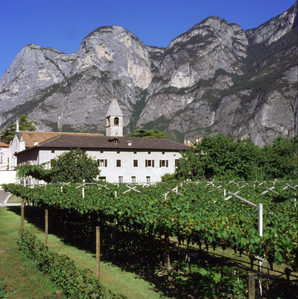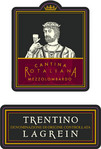
 |
| The renowned Rotaliano plain in Italy’s northern Trentino region is one of the world’s most fascinating vineyard sites. It is the home of the native Teroldego grape, the first Trentino wine to be granted DOC status in October 1971. The entire DOC Teroldego Rotaliano is about 500 ha, exclusively on the Rotaliana plain (Campo Rotaliano or Piana Rotaliana, the terms are used interchangeably).
Cantina Rotaliana was established in 1931. Its 160 hectares of vineyards are planted with mostly Teroldego, and a small amount of Lagrein (8 hectares). The vines are located on the best parts of the plain only, the western side, which is the former Noce River bed, rich in glacial sediment. Each vine is pruned to leave only two fruit-producing canes for the upcoming vintage. From the start of the season through the summer, the Rotaliana team manages the leaf canopy by hand, to ensure optimal exposure to sunlight and air while also removing unwanted shoots. After veraison in mid-July, the bunches are thinned to reduce the size of the crop and enhance its health. Farming practices: sustainable. Grass grows between the rows. No chemical fertilizer is used, to ensure the vitality of the soil and a healthy natural ambiance. 2012 vintage: a long growing season with perfect weather at harvest time. The vintage has an exceptional balance of concentrated fruit, deep color and freshness. |
| Cantina Rotaliana Website |
 |
| Teroldego |
| 100% Teroldego. The name Teroldego derives from the traditional method of vine-training with wires, called “ tirelle". The entire vineyard is only 400 hectares in size. It was formed in ancient times by a glacier, which broke through what is now the Rocchetta Pass to the north, and flattened a plain surrounded by massive mountains. The unique combination of the fertile valley floor with a gravelly top soil - nourished by the Noce and Adige Rivers, and the surrounding mountains that protect the vineyards from the North wind and retain warmth - create perfect conditions for ripening Teroldego and Lagrein grapes. The double canopy system exposes the foliage to the sun and permits the circulation of air around the bunches, while extending the ripening cycle. Teroldego has large and heavy triangular bunches with thick-skinned, dark blue berries. The grape has a low level of natural tannin but is high in color, fruity acidity and ripening potential - in short, ideal for producing lush, deeply flavored yet fresh, expressive and complex wines. The Teroldego grapes are harvested by hand at optimal ripeness, hand-sorted in the vineyard, and then transported to the winery in small boxes. The fruit is de-stemmed and the grapes gently crushed to release the juice, which descends by gravity into stainless steel fermentation tanks. Fermentation begins with the native yeasts present on the skins, and proceeds at a controlled temperature of only 26 Centigrade to preserve the wine’s aromatic and fruity quality. The fermenting juice is sprayed over the cap of skins by an internal pump to ensure soft extraction of tannins. After a first racking, malolactic fermentation occurs spontaneously in October, and is followed by a 2nd racking in November to remove solids and aerate the young wine. The tanks are assembled in June, lightly filtered with diatomaceous earth, and the wine is bottled before the next harvest. Blue-purple color and succulent, bright flavors of black-cherry, wild blueberry, dark plums and notes of smoke, herbs and almonds. 12.5% Alcohol. 15,000 cases produced. |
 |
| Trentino Lagrein |
| 100% Lagrein, from the best selected vineyards within the classic production area of Piana Rotaliana. 45 year old vines. The soil is not very deep, with pebbles and gravel, rather fertile. Lagrein is thought to be a descendant of Teroldego, and shares many of its characteristics. While it is known in other north Italian regions, when cultivated in the same way as Teroldego on the Rotaliana plain, it attains unsurpassed maturity. The Lagrein grapes are harvested by hand at optimal ripeness, hand-sorted in the vineyard, and then transported to the winery in small boxes. The fruit is de-stemmed and the grapes gently crushed to release the juice, which descends by gravity into stainless steel fermentation tanks. Fermentation begins with the native yeasts present on the skins, and proceeds at a controlled temperature of only 26 Centigrade to preserve the wine’s aromatic and fruity quality. The fermenting juice is sprayed over the cap of skins by an internal pump to ensure soft extraction of tannins. After a first racking, malolactic fermentation occurs spontaneously in October, and is followed by a 2nd racking in November to remove solids and aerate the young wine. The tanks are assembled in June, lightly filtered with diatomaceous earth, and the wine is bottled before the next harvest. Aged for 3 months in bottle before release. Black-purple color and a supple texture with generous, dark cherry, licorice and black plum fruit highlighted by floral violet and mineral notes. 12.5% Alcohol. 2,500 cases produced. |
| Copyright © 2002-2017 VOS Selections, Inc. |